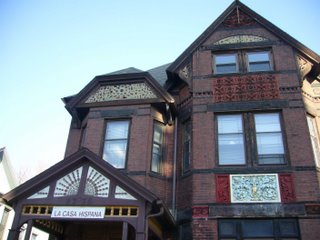La Casa Hispana
 One of the nicknames for Springfield, Massachusetts, dating from the Victorian era, is "the City of Homes." Springfield in the late nineteenth century had an uncommon number of single-family residences. And an uncommon number of those residences were beautiful and interesting.
One of the nicknames for Springfield, Massachusetts, dating from the Victorian era, is "the City of Homes." Springfield in the late nineteenth century had an uncommon number of single-family residences. And an uncommon number of those residences were beautiful and interesting.Many of these homes, notably in the McKnight district, Forest Park, and my own Armoury-Quadrangle district, remain in distinct 19th-century neighborhoods. Many others (James Whistler's, for cripe's sake!) have been razed for projects such as Interstate 91 or the strip malls and medical buildings of the New North. Still others remain, isolated from other buildings of their era, standing with folorn dignity amidst parking lots, vinyl-sided raised ranches, and Butler Buildings.
One of the latter is the Casa Hispana, located on Main Street in the North End of Springfield, across the street from the McDonald's. It's headquarters of the Spanish-American Union, established in 1968 when a good part of the North End was razed for the interstate and for professional buildings, displacing many Puerto Ricans. The Casa Hispana houses several social service agencies dedicated to improving the lives of Puerto Rican citizens.
It's a funky building that has long fascinated me. One of these days I'm going to research the history of the structure. It looks to be about the age of my own house.
La Casa Hispana is red brick, with the contrasting bands of black found on some of Mattoon Street's rowhouses. It's got quite a bit of terra cotta decoration, similar to that found on the chimney of the house across the street from me. But from there, it pretty much goes off in its own fantastical direction.
Bricks on the side of the house are set in checkerboard and diamond patterns. Gables and porches are supported by carved wooden brackets. Over each window and door is a fanciful pediment. No two are alike. Mostly they're mosaics of shells and stones. My favorites are what look to be broken bottles set in mortar.
The exterior of my own home, the Pascal Emory House, needs a bit of carpentry. One gutter has to be replaced, one or two brackets need repair, and a half-dozen slate tiles are chipped. Nothing major at all--just the kinds of things you get done when you have the house painted. And the house could use a paint job. There are enough brackets, cornices, moldings, and trims to support five or six colors, if I want to go the Painted Lady route.
There's really no place to put a bottle-glass mosaic, however. It's just not that kind of house. More's the pity. Loking at the Casa Hispana, and at my growing bottle collection, it's one of the many things I fantasize about.
Labels: architecture, Springfield


1 Comments:
R u still in the same location
Post a Comment
<< Home